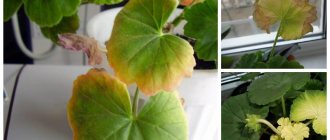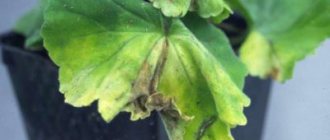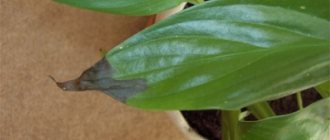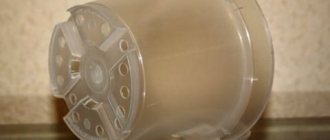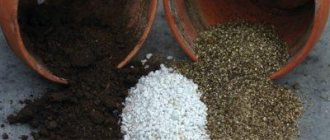When and how can pelargonium leaves lighten?
In healthy pelargonium, the color of the leaf blade has a light or dark green tint (depending on the variety). This appearance is the norm. Sometimes there is a complete or partial lightening of the color; the cause may be unsuitable conditions, errors in care or illness.
The appearance of white leaves is a bad sign
Most often, symptoms appear in winter. At this time, it is most difficult to provide the flower with the necessary amount of light and optimal air humidity. In this case, the leaves may not only turn white, but also turn yellow. Problems associated with nutrient deficiencies can occur at any time of the year.
Additional Information! Leaves may turn white only at the edges or in the central part of the plate. Sometimes small pale spots appear. Measures are taken depending on the color and degree of damage to the flower.
What to do if the plant turns pale - detailed instructions
To restore the leaves to a healthy appearance, you must follow these recommendations:
First of all, it is important to ensure a sufficient flow of oxygen for the plant: remove it from the sun, ventilate the room, and take it out into the fresh air. After just a couple of weeks, you will notice that the light leaves have gradually begun to “come to life.”- To solve the problem of insufficient lighting in the summer, you need to place the flower on the sunny side or on the balcony.
However, you should avoid direct sunlight. They can cause burns and yellowing of the leaves. In winter, geraniums can be illuminated with special lamps. Important! Direct sunlight can burn the plant's leaves. - To compensate for iron deficiency, you can use special fertilizers.
Some of them are introduced through the leaf, which allows the active substances to enter the plant tissue within a few hours. Some are added during watering, but the effect will have to wait up to 3 days. If iron is present in the soil, but the plant does not absorb it, then it is necessary to improve soil drainage or replant the flower. There is a proven method for saturating the soil with iron. Rusty nails are buried in a pot with a plant. The main thing is the presence of rust, which can be cleaned off from rusty objects and added to the ground. - In order not to overload the soil with fertilizers, they must be used in strict accordance with the instructions. If the composition of the soil is already damaged, then it is better to replace it with a new one. The new soil should be light and moisture-permeable.
- When controlling pests, it is important to choose the appropriate product. Repeated spraying will be required, as well as removal of infected parts. If the treatment does not bring visible results, then it is better to get rid of the flower so that healthy specimens do not become infected.
Errors in care
Why do the leaves of indoor roses turn yellow and cobwebs appear?
Unsuitable conditions and failure to follow care instructions can affect the health of the flower. Reasons for the appearance of light colored leaves:
- Lack of sunlight. Low light can cause leaf color to lighten or completely white leaves to appear. This problem is especially acute in winter.
- Lack of nutrients. Depleted soil and lack of fertilizing can cause not only lightening of the leaves, but also a slowdown in growth. It is important to regularly feed your indoor flower during flowering in the summer. The most common symptom is lightening of the leaf edges.
- Excessive feeding. Not only a deficiency, but also an excess of nutrition is harmful to pelargoniums. Frequent application of fertilizers is simply dangerous.
- High temperatures. Too warm and dry climate harms flowers. In winter, heating radiators dry out the air, having a negative effect on the plant.
Having assessed the listed factors, you can find the reason why geranium leaves lighten. Once a problem is identified, action should be taken immediately.
Even one white leaf is a signal to take action
Features of indoor flower growth, including in summer
Geraniums can bloom all year long if they receive enough light. This can be achieved by placing it on the south side of the apartment. A comfortable temperature for geraniums in winter is not lower than 10 degrees.
To maintain a beautiful, lush crown, you need to regularly pinch new shoots, trim and remove faded inflorescences. In the fall, the plant is thoroughly pruned. In spring, for active flowering, it is necessary to pinch the top.
In summer, the plant needs abundant watering as the soil dries out. Overwatering leads to rotting of the soil. The soil must have drainage for air circulation.
Diseases
Sometimes the lightening of the color of the leaves appears simultaneously with the appearance of a light coating on their lower part. This is a signal of fungal development. The reason is excessive watering or the transfer of the disease from other plants in the apartment.
Why do the leaves of indoor roses turn yellow at home?
In this case, the flower should be treated. Complex treatment with drugs is carried out. In case of a severe stage of the disease, a transplant is carried out with a complete replacement of the soil and container.
Note! During recovery, the flower is isolated from other plants.
After the flower has fully recovered, the watering regime must be strictly observed. Otherwise, the disease may return and lead to disastrous consequences, and it will be more difficult to fight it.
Preventive measures
Disease prevention is carried out in combination with other measures that support the growth and development of geranium.
List of measures:
- create optimal temperature conditions;
- provide sufficient lighting;
- create normal soil moisture;
- make drainage so that water does not stagnate in the pot;
- provide a high-quality substrate;
- control over the application of fertilizers;
- daily inspection of leaves for damage;
- removing damaged and dried leaves and stems;
- control over the general condition of the plant.
To enjoy blooming geraniums for a long time, you need to provide them with appropriate care. Then she will be able to restore her vitality in a timely manner and delight the eye with lush flowers and a healthy crown all year round.
How to help pelargonium and what to do with white leaves
You need to figure out why geranium leaves turn white and what to do about it. The nature of the measures that need to be taken depends on the cause of the color change. If there is a lack of light, move the pot to a bright windowsill; if there is low humidity and high temperature, find a cool place and place a tray with expanded clay next to it. The problem with fertilizing can be solved by increasing the frequency of their use or temporarily abandoning them. White leaves are not viable, and also spoil the appearance of the plant, so they are carefully removed.
Why does the leaf blade turn white?
Chlorophyll in the leaves ceases to be produced for several reasons:
- Lack of oxygen. Leaves become discolored due to lack of oxygen. This usually happens during hot months. The plant is located in a place where air circulation is disrupted and it warms up above a comfortable temperature for geraniums. The plant's oxygen exchange is disrupted and it stops producing green pigment.
- Lack of light. Geranium is a light-loving plant. Lack of sun and natural light negatively affects the life of the plant. It also stops producing chlorophyll.
- Iron deficiency. The leaves turn white due to a lack of iron in the soil. In such cases, iron-containing fertilizers are used.
- Excess fertilizer. Excess fertilizer leads to disruption of the chemical composition of the soil. The plant is not able to properly absorb beneficial microelements.
- Disease Such consequences can occur due to infection of the flower by various pests. Gray rot manifests itself in a similar way (what leaf diseases occur in geraniums?).
Prevention
The best prevention of any diseases and deterioration in the appearance of pelargonium is strict adherence to the rules for the care and maintenance of the plant. That means:
- compliance with the watering and fertilizing schedule;
- maintaining optimal levels of temperature and humidity;
- ensuring sufficient lighting.
It is enough to follow simple rules for the full development of pelargonium
One of the problems that owners of pelargoniums may encounter is changes in leaf color. At the same time, an analysis of the conditions of the flower is carried out in order to understand why the leaves of geraniums turn pale. This is usually caused by errors in maintenance or as a consequence of diseases. Timely measures will help restore the plant to a healthy appearance and allow it to fully develop.
Why did the leaves turn white?
Why does the color of the leaves lighten and they become pale? Like any plant, geranium reacts to disturbances in care. In particular, due to prolonged exposure to elevated temperatures, geranium leaves turn white. Changes in crown pigmentation usually occur in the summer.
The air temperature near the window on hot sunny days is many times higher than outside. Therefore, if the plant is located on a windowsill, it may suffer heat stroke.
As a result, geranium leaves grow completely discolored. Also, the existing healthy crown may gradually lose color and turn pale. The entire leaf, or just its border, becomes colorless. This is due to the fact that the production of chlorophyll is disrupted.
How to save a flower
The main thing in eliminating the cause of whitening of foliage is to understand why geraniums have this problem. You can use several simple methods to save a flower from illness:
- Pay attention to the size of the pot; although geranium is a picky plant, it is not recommended to use absolutely any pot. Lack of space for the full development of the root system can cause problems with the color scheme of the leaves. A small or large size pot will not work; a container with a diameter of 25–40 cm would be ideal.
- Stop watering the plant completely, let only the top layer of soil be moistened. When the flower feels better and obvious signs of the disease have passed, moderate watering can be resumed.
- During the cold period, avoid exposing pelargonium to drafts, and also do not place the pot next to heating devices.
- Do not get carried away with various types of fertilizers, especially nitrogen-containing ones. Be sure to follow the instructions on the packaging. In summer, potassium is added to the soil; in winter, it is not fertilized at all.
- If the reason for the whitening of the leaves lies in the infection of the geranium with bacteria, fungi or insects, then it is impossible to do without chemicals. One treatment will not be enough; at least 5 sprayings will be needed, at intervals of a week. Unfortunately, not all parasites can be gotten rid of, so if a deterioration in the condition of a flower is noticed even after intensive treatment, it would be better to simply get rid of it so as not to infect other healthy indoor plants.
The rules of care are quite simple; by following them, you can ensure your pelargonium has a beautiful, healthy appearance. You need to love and understand the plant, and it will always reciprocate.
Healthy geranium and conditions for this
Pelargonium is a tropical plant, unlike true geranium (crane beetle), which survives calmly in the most extreme conditions and mainly grows in the garden.
Tropicans need to create conditions that are similar to those prevailing in the Amazon jungle. This includes humidity, moderate watering without stagnant water, plenty of light, and lack of heat in summer.
In winter, such plants should be kept in a cool room, which is rare for the middle zone, since everyone heats their homes with convectors and radiators.
Most often, the following picture is observed: a person buys a beautiful flowering plant, admires it, but after a period of dormancy, the leaves of the geranium turn yellow and dry, there are no signs of growth, and buds do not form. When the housewife thinks about what to do, it is usually too late - the flower dies.
The way out of the situation is that before buying beautiful tropical crops, you need to analyze whether it is possible to provide them with conditions for growth and flowering in the apartment. Or is it better to buy something domestic that will put up with the realities of the middle zone.
Diagnosis of the problem
Often during hot periods, housewives notice whitened leaves on geraniums. They may gradually lose color, or grow white. The production of chlorophyll is disrupted . In some cases, the leaves turn white only at the edges, while the center remains green. It may also be that white spots appear, and the surface of the leaf becomes limp and wrinkled (read about why spots appear on geranium leaves and how to cope with the problem, and from this article you will learn about why the leaves of the plant curl ).
If geranium leaves dry out: what to do?
First of all, you need to pay attention to the type and nature of the external manifestations of the disease. If dry spots appear on the plant's leaves, the problem can probably be eliminated by thoroughly watering the soil. If the spots are brown, it is likely that there is too much water in the soil.
If the damage looks more like a dent or blister, it is possible that the plant is being bothered by pests. If the leaves curl and fall off, there may be several reasons. This is cold, improper watering, excessively dry air. You need to try to critically assess the situation and provide first aid to the flower: if it is dry, water it, if it is hot, take it to the shade. Continue to observe the geranium and you will definitely determine the cause of the damage.
How to prevent the disease?
Yellowing geranium leaves are the first signal that the plant is sick. Therefore, there is no need to hesitate. First you need to try to understand what could have caused the disease. To do this, it is worth reviewing flower care, identifying all mistakes, analyzing them and correcting them.
Pelargonium should grow in conditions of average temperature, the value of which cannot be lower than +12 and higher than +20°C. It is best to leave a flower pot on an insulated balcony or apartment window sill. The room should be well lit. The key to a healthy appearance of geraniums is regular ventilation. But winter drafts are best avoided.
The flower grows well in loose and light soil. It is imperative to create drainage to drain excess fluid. It is recommended to replant pelargonium once every 2 years, when the pot becomes too small for the plant. The procedure for transferring the crop to a new location is carried out in the spring.
During the flowering period, which lasts from mid-March to the end of August, geraniums are periodically fed. Florists recommend using liquid complex phosphorus-potassium supplements for indoor plants. Do not overuse nitrogen compounds.
Watering the flower should be regular, but not too much, so that the water does not stagnate at the roots. If rot does affect the crop and signs of blackleg appear, then it is better to destroy the geranium bush so as not to infect nearby plants.
When following all the rules for caring for pelargonium does not give a positive result, and the leaves continue to dry out and turn yellow, it is advisable to treat the ornamental crop against pests. Indoor plants often become targets for small insects that parasitize the green parts of flowers. You can get rid of them by using one of the industrial products that are sold in specialized stores.
But such drugs must be used carefully, strictly following the instructions for use and safety precautions.






